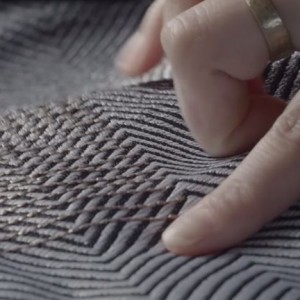Wearable kinesthetic systems for capturing and classifying body posture and gesture
By Alessandro Tognetti, Federico Lorussi, Mario Tesconi, Raphael Bartalesi, Giuseppe Zupone, Danilo De Rossi
The main idea in this article is the exploration of kinesthetic garments to be used for rehabilitation, sports and media purposes. These garments were tested and the results were comparable to ones derived from commercial electrogoniometers.
The Upper Limb Kinesthetic Garment (ULKG) is able to detect the posture of the wrist, elbow and shoulder. It would be used for post-stroke patients. The advantage to this is that patients can be monitored and rehabilitated outside of the hospital in any location as long as the garment is being worn.
Another garment is the kinematic models of human joints. Ideal joints of the body are used to determine the range of movement required in the model. Firstly, sensors pick up of the position of the body part. In this case, the arm and shoulder is used as an example.
Wearable Electronics and Smart Textiles: A Critical Review
By Matteo Stoppa and Alessandro Chiolerio
The following review focuses of the advancements of smart textiles. It especially explains the materials used and the processes needed for creating such textiles. Each method has its own benefits and drawbacks. Through the understanding of these methods, the researchers strive to strike a balance between flexibility, functionality, low-energy consumption etc.
Smart textiles are categorised into passive smart textiles that are only able to sense the environment. Active smart textiles are able to react to the stimuli from the environment and very smart textiles take it one step further and adapt to the given circumstances
The way smart textiles work is that sensors provide a nerve system to detect signals that are triggered or stimulated by elements like temperature, light, movement and so on. These signals are analyzed, evaluated and result in a response or action. The different processes involved in creating and processing fabric include sewing , embroidery, knitting, printing, coating etc.
Smart materials include conductive fibers, treated conductive fibers, conductive fabrics, inks, stretch sensors and pressure sensors.
In conclusion, after reading the two articles, I learned the ways electronics can be incorporated into clothing in a seamless way. These garments are able to function as a second skin.

Tiffany, I am impressed with your summary essay, especially given the complex nature of these essays. Galina is the expert in this area and she will provide you with more specific comments regarding the content of your essay. But I would like give you a few recommendations for your research critiques: (1) Be sure and provide a quote from the essay, and use that reference to support your comments. (2) It is helpful to provide media (images) and links to help illustrate your comments. (3) I would also suggest that you do more summarization and attempt to synthesize your response. Don’t be afraid to include your own comments, questions about things you didn’t understand, and personal reflections on the essays. I thought your conclusion was most interesting because it reflected an original observation on your part. In other words, you don’t need to just repeat things that are stated in the essay, but rather, provide a personal response that indicates what you are thinking about including your reflections on the essay. We can discuss this further in class.